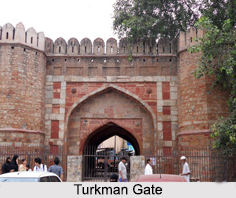 Located to the southern edge of Shahjahanabad, the Turkman Gate is in close proximity to the Ramlila grounds and can be easily accessed from the Jawaharlal Nehru Road and the old Circular Road. The gate has a square plan with high arched openings. It is a part of the gates of Delhi and is named after the Sufi Saint Shah Turkman Bayabani, whose tomb dated to 1240 is located to the east of the gate. Other places of interest like the tomb of Razia Sultan and the Kali Masjid are located close to the Turkman Gate.
Located to the southern edge of Shahjahanabad, the Turkman Gate is in close proximity to the Ramlila grounds and can be easily accessed from the Jawaharlal Nehru Road and the old Circular Road. The gate has a square plan with high arched openings. It is a part of the gates of Delhi and is named after the Sufi Saint Shah Turkman Bayabani, whose tomb dated to 1240 is located to the east of the gate. Other places of interest like the tomb of Razia Sultan and the Kali Masjid are located close to the Turkman Gate.
Turkman Gate Demolition
An infamous case of political oppression and police brutality, the Turkman Gate demolition was a part of Indira Gandhi"s 21 month Emergency period from 1975 to 1977. The demolition of the Turkman Gate, which followed in riots, was done in 1976.
Part of the Emergency programme was the demolition drive to cleanse Delhi of slums and force the poor residents to leave the city and move to distant settlements. This action was prompted by Sanjay Gandhi, the son of Indira Gandhi. The residents of Turkman Gate resisted and refused to move as they would have to commute every day paying heavy bus fares to reach the city to earn their living. Hence, on 18th April, 1976, the police opened fire on protesters killing several of them. Due to the government imposed censorship on media and newspapers, there were no reports on the massacre. Foreign media outlets had reported that protesting people were ran over by bulldozers.
This article is a stub. You can enrich by adding more information to it. Send your Write Up to content@indianetzone.com.



















